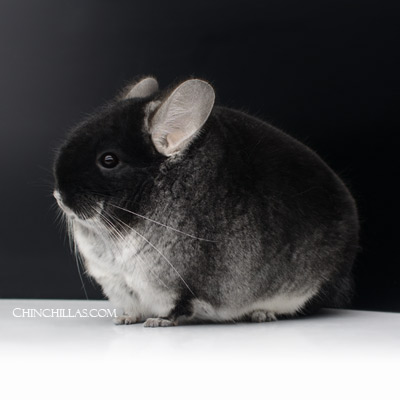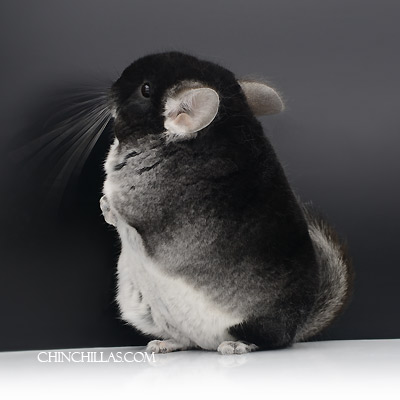Black Velvet Chinchillas

Gunning Black Velvets are among the highest quality, and most in-demand of all chinchilla mutations. The early Black Velvets had the benefit of being developed in a high quality standard herd, of being a dominant mutation thus easier gene to improve, and the financial benefit of having a high value in the fur market. Further, the existence of a genetic lethal factor - preventing the homozygote - limits the supply of Black Velvets. Together, these factors contribute to consistent high demand for the best quality Blacks. Today, the mutation is greatly valued among hobbyist breeders. A well bred Gunning Black Velvet can contribute color, size, substance, and quality to its offspring.
 Mr. Robert Gunning of eastern Washington State was the breeder most responsible for the early development of the Black Velvet mutation. The first animal to show the phenotypic characteristics of the Black Velvet gene mutation had only a dark area on the top of the nose. Through his years of hard work, Bob Gunning was able to extend the dark veiling back along the entire grotzen to the base of the tail. The Black Velvet gene did more than affect a black color. It also gave the fur within the veil a silky texture; thus the name ‘Black Velvet.’
Mr. Robert Gunning of eastern Washington State was the breeder most responsible for the early development of the Black Velvet mutation. The first animal to show the phenotypic characteristics of the Black Velvet gene mutation had only a dark area on the top of the nose. Through his years of hard work, Bob Gunning was able to extend the dark veiling back along the entire grotzen to the base of the tail. The Black Velvet gene did more than affect a black color. It also gave the fur within the veil a silky texture; thus the name ‘Black Velvet.’
In 2024 Lisa Paternoster, daughter of Robert Gunning, provided the following account of her father’s contribution to the Black Velvet chinchilla:
During the 1950’s, Robert (Bob) Gunning lost his entire herd of chinchillas to a fire. He considered retiring from the chinchilla industry, but instead [and fortunately for the fate of what would later become the Gunning Black Velvet] he decided to seek out a new herd. At a show, believed to have been located in Utah, Bob saw an unusually marked female chinchilla owned by Herb Chase. Bob offered to buy the female, but Herb wanted to sell the entire herd. So as fate would have it, Bob Gunning bought the entire herd of 50 chinchillas. The unusually marked female within the herd was the first known ‘Black [or F0 mutant].' Bob endeavored to study genetics with some help from Washington State University. He knew he would need a male offspring if he was to have success developing the new mutation. After three attempts, the unusually marked female gave birth to a male. From that point on, it took Bob 11 years to develop the mutation. Being a ‘product of nature,’ Bob was not able to patent the new mutation, so he guarded his animals carefully, and also enlisted the help of his friend Bert Colby of Quincy, Washington. Bert took several Black chinchillas into his own herd, to help speed up the process of propagating the Blacks, and also to safeguard the new mutation against fire or mishap. At the 11 year mark, Bob Gunning took 11 of his ‘Black Velvets’ to 11 shows across the United States. He won almost every trophy during the show tour, save just a few, and by the end of the tour every chinchilla breeder wanted a Black Velvet! Following, in the late 1960’s, Bob went on another tour, this time to various major cities where he sold the Black Velvets by lottery. Bob Gunning continued in the chinchilla industry until approximately 1984, at which time he sold his herd and went back to farming dry land wheat full time. He loved the chinchilla industry and made many lifelong friends. Robert Gunning passed away in December of 2020 at the age of 89.
‘Gunning Black Velvet,’ ‘Black Velvet,’ or the abbreviated ‘Black,’ are all correct terminology for the mutation. The Black Velvet mutation is sometimes referred to (incorrectly) as ‘TOV.’ The acronym TOV stands for ‘Touch of Velvet.’ The term TOV or Touch of Velvet was coined for the fur market - indicating 'Beige with a Touch of Velvet.' The 'Touch of Velvet' pelt was produced by the first Gunning Black Velvet hybrid - being a heterozygous Gunning Black Velvet & heterozygous or homozygous Tower Beige chinchilla.
The Gunning Black Velvet gene is a heterozygous-only dominant. When breeding dominant color mutations it is important to keep in mind that there are genetic lethal factors associated with both the Gunning Black Velvet and Wilson White genes. Neither of these two color mutations can exist in the homozygous form. When a Gunning Black Velvet or a Gunning Black Velvet hybrid is bred to another Gunning Black Velvet or Gunning Black Velvet hybrid the result is 25% less offspring produced than anticipated. The failed conception occurs when both the sire and the dam throw the mutant Gunning Black Velvet gene.
 The depth of black color along the grotzen of the Gunning Black Velvet is unrivaled by other chinchilla mutations. Even the darkest ebonies do not compare. In the rare instances that a truly competitive dark ebony challenges a black velvet, it is not uncommon for the ebony to be a TOV Ebony, or Black Velvet/ebony hybrid, thus also possessing the Gunning Black Velvet veil.
The depth of black color along the grotzen of the Gunning Black Velvet is unrivaled by other chinchilla mutations. Even the darkest ebonies do not compare. In the rare instances that a truly competitive dark ebony challenges a black velvet, it is not uncommon for the ebony to be a TOV Ebony, or Black Velvet/ebony hybrid, thus also possessing the Gunning Black Velvet veil.
Additionally, for reasons that are not clearly known, when a chinchilla presents with typical Brevicaudata characteristics, it is most often a Black Velvet. It is possible that either to original F0 mutant female, or the Gunning herd, carried a higher than average percentage of Brevicaudata blood. The distinguishing characteristics of the Brevi chinchilla include short ears and tail, a distinct convex profile, slow maturity, and sluggish reproduction. Many of these characteristics apply to the Gunning Black Velvet as well.
Breeders should be aware that some females have difficulty littering kits with the Brevi-type head. Therefore, it is better to cross a large brevi-type Black Velvet female to a quality Lanigera-type male of equal or smaller size. A Brevi-type Black Velvet male, especially a large one, should only be crossed with even larger females possessing the conformational capacity to litter such kits.
A well bred Gunning Black Velvet chinchilla should have good clarity, a bright white belly showing no creaminess and no grey/brown tip on the white hairs, especially between the front legs. This grey/brown tip often indicates the presence of a charcoal or ebony/wrapping gene in the background of the animal, and is undesirable unless the chinchilla will be bred to ebonies or ebony hybrids. Chinchillas with the Gunning Black Velvet gene should show complete silky textured veiling from the tip of the nose to the base of the tail with little to no break in veiling at the back of the neck (called a halo) or elsewhere. There should also be a distinct gradation from black on the grotzen, to grey, to a white belly. There should not be an abrupt change directly from a black grotzen to a white belly. It can take a year or (frequently) more for a Gunning Black Velvet or Black Velvet hybrid chinchilla to completely mature and veil out. Additionally, Black Velvets can be slow to produce offspring.
Today, the Gunning Black Velvet gene is responsible for wide variety of especially beautiful hybrid chinchillas. There is of course the first hybrid - the TOV or TOV beige, along with TOV white, TOV pink white, TOV sapphire, TOV violet, TOV blue diamond, TOV ebony, TOV tan, etc.... It is difficult for any other mutation or hybrid chinchilla to rival the aesthetics of a finely bred Black Velvet. Their simple beauty is perhaps unsurpassed!
Visit the Chinchillas.com Auction database to view additional pictures of Black Velvet or Black Velvet hybrid chinchillas, or see new chinchillas for sale in the Sales Gallery.